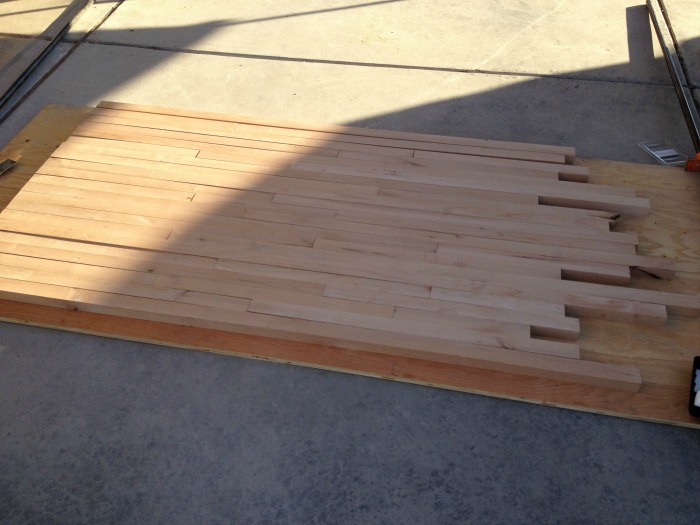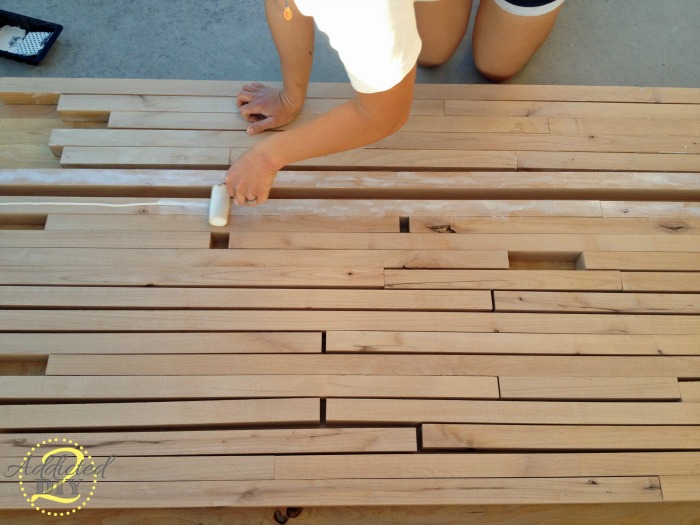Building your butcher block countertop can be a rewarding project that combines functionality with aesthetic appeal. A butcher block countertop offers a warm, natural look and a durable surface for kitchen tasks. To begin, selecting the right wood is crucial. Hardwoods like maple, oak, walnut, and cherry are popular choices due to their durability and resistance to damage. Each type of wood has unique characteristics; for example, maple is known for its tight grain and light color, while walnut offers a rich, dark hue. It’s essential to choose wood that is properly dried and free of defects, as these can affect the integrity and appearance of the countertop.
Once you have your wood, the next step is to cut the boards to the desired length. It’s important to measure your space accurately and plan the layout of your boards to ensure a consistent pattern. Most butcher block countertops feature edge grain or end grain construction. Edge grain countertops are made by gluing boards together with the edges facing up, creating a smooth, linear appearance. End grain countertops, on the other hand, are made by arranging the ends of the boards upward, resulting in a checkerboard pattern that is exceptionally durable and ideal for heavy chopping.
After cutting, you’ll need to join the boards together. This process involves applying wood glue to the edges of the boards and clamping them tightly until the glue dries. It’s crucial to use a high-quality, waterproof wood glue to ensure a strong bond. Clamps should be spaced evenly along the length of the boards to apply consistent pressure and prevent gaps. It’s a good idea to use cauls—straight pieces of wood placed across the width of the countertop and clamped at the ends—to help keep the boards flat while the glue dries.
Sanding is the next step. Begin with a coarse-grit sandpaper to remove any excess glue and level the surface, then progressively move to finer grits to achieve a smooth finish. Sanding not only enhances the appearance of the wood but also prepares it for finishing. It’s important to sand in the direction of the grain to avoid scratches and achieve an even surface. Once sanding is complete, thoroughly clean the surface to remove all dust and debris.

Finishing the countertop is a critical step that protects the wood and enhances its natural beauty. There are several options for finishes, including oils, varnishes, and polyurethane. Food-safe mineral oil is a popular choice because it penetrates the wood, enhancing its grain and providing a degree of moisture resistance. For a more durable finish, consider using a combination of oil and beeswax, which offers additional protection and a subtle sheen. Polyurethane provides a tough, water-resistant finish but can give the wood a slightly plastic look. Regardless of the finish you choose, apply it in thin, even coats and allow each coat to dry completely before applying the next.
Installing the butcher block countertop involves securing it to your cabinets. This typically requires screws and brackets, which should be placed at regular intervals to ensure stability. Pre-drill holes to prevent splitting the wood, and use screws that are long enough to provide a secure hold but not so long that they penetrate the surface of the countertop. If your countertop will be near a sink, it’s especially important to seal all edges and cutouts to prevent water damage.
Maintaining your butcher block countertop is essential to preserve its appearance and functionality. Regularly oiling the surface helps to maintain its luster and prevent drying and cracking. Clean the countertop with a damp cloth and mild soap, and avoid using harsh chemicals or abrasive cleaners, which can damage the finish. Minor scratches and stains can often be sanded out and refinished, but deeper damage may require more extensive repair.

Adding custom features like an integrated cutting board or a built-in knife slot can enhance the functionality of your butcher block countertop. These features can be incorporated during the construction phase or added later. For example, a recessed cutting board can be made by routing a shallow area into the surface of the countertop, providing a dedicated space for chopping without compromising the overall look.
To further personalize your countertop, consider adding decorative touches like inlays or edge profiles. Inlays can be made from contrasting wood species, creating a striking visual effect. Edge profiles, such as beveled or rounded edges, add a finished look and can make the countertop more comfortable to use. These details require careful planning and precise execution but can significantly enhance the beauty of your project.
If you prefer a more rustic or reclaimed look, consider using salvaged wood for your butcher block countertop. Reclaimed wood often has unique character and history, adding a distinctive touch to your kitchen. When using salvaged wood, it’s important to ensure that the boards are properly cleaned and treated to remove any contaminants. Additionally, reclaimed wood may require more preparation, such as planing and sanding, to achieve a smooth, even surface.
Incorporating a backsplash or upstand with your butcher block countertop can protect your walls from splashes and spills while providing a cohesive look. A matching wood backsplash creates a seamless appearance, while a contrasting material like tile or stainless steel can add visual interest. When installing a wood backsplash, be sure to seal all joints and edges to prevent moisture infiltration.

Environmental considerations are also important when choosing wood for your butcher block countertop. Look for sustainably harvested wood or products certified by organizations like the Forest Stewardship Council (FSC). Using environmentally friendly finishes and adhesives can also minimize your project’s impact on the environment. By making conscious choices, you can create a beautiful and sustainable kitchen feature.
Cost is another factor to consider when building a butcher block countertop. While purchasing raw materials and doing the work yourself can save money compared to buying a pre-made countertop, it’s important to budget for all necessary supplies, including wood, glue, clamps, sandpaper, and finish. Additionally, factor in the value of your time and any specialized tools you may need to purchase or rent.
Finally, building a butcher block countertop is not just about the finished product but also about the process. Taking the time to plan carefully, execute each step meticulously, and appreciate the craftsmanship involved can make the project immensely satisfying. Whether you’re an experienced woodworker or a DIY enthusiast, the skills and knowledge gained from creating your own countertop can be valuable for future projects.

Common Mistakes to Avoid
Inaccurate Measurements: Failing to measure the space accurately can result in a countertop that doesn’t fit properly. Double-check all measurements before cutting your boards.
Poor Wood Selection: Choosing the wrong type of wood or wood that is not properly dried can lead to warping and cracking. Select high-quality, kiln-dried hardwoods.
Insufficient Clamping: Not using enough clamps or unevenly clamping the boards can cause gaps in the joints. Ensure even pressure across the entire surface during gluing.
Improper Sanding: Skipping grits or sanding against the grain can result in a rough surface and visible scratches. Sand progressively with finer grits and always sand with the grain.
Inadequate Finishing: Applying the finish too thickly or not allowing it to dry properly can create a sticky surface. Apply thin, even coats and follow the manufacturer’s drying instructions.
Neglecting Maintenance: Failing to regularly oil the countertop or using harsh cleaners can damage the wood. Maintain your countertop with appropriate care to ensure its longevity.
Ignoring Environmental Factors: Not accounting for wood expansion and contraction due to humidity changes can lead to cracks. Leave space for expansion and consider the kitchen’s environment.

What type of wood is best for a butcher block countertop?
The best wood types for butcher block countertops are hardwoods such as maple, oak, walnut, and cherry. These woods are durable, resistant to damage, and offer a variety of aesthetic options. Maple is often favored for its light color and tight grain, while walnut provides a darker, rich appearance. It’s important to choose wood that is properly dried to prevent warping and cracking.
How do I maintain a butcher block countertop?
Maintaining a butcher block countertop involves regular cleaning and oiling. Clean the surface with a damp cloth and mild soap, avoiding harsh chemicals and abrasive cleaners. Regularly oiling the countertop with food-safe mineral oil or a combination of oil and beeswax helps to maintain its moisture and prevent drying and cracking. Address minor scratches and stains by sanding and refinishing the affected area.
Can I install a butcher block countertop near a sink?
Yes, you can install a butcher block countertop near a sink, but it requires extra care. Ensure that all edges and cutouts are thoroughly sealed to prevent water damage. Regularly apply finish to maintain the wood’s resistance to moisture. Consider installing a sink with an integrated lip or using a waterproof mat to further protect the wood.
How do I fix scratches or stains on my butcher block countertop?
Minor scratches and stains can often be repaired by sanding the affected area with fine-grit sandpaper and reapplying the finish. For deeper scratches or significant damage, you may need to sand down the entire surface and refinish it. Always sand in the direction of the grain to avoid additional damage and achieve a smooth finish.
What finish should I use for my butcher block countertop?
The choice of finish depends on your preferences for appearance and durability. Food-safe mineral oil is popular for its ability to penetrate the wood and enhance its natural beauty while providing some moisture resistance. For greater durability, a combination of oil and beeswax can offer additional protection. Polyurethane provides a tough, water-resistant finish but may alter the wood’s natural look. Apply finishes in thin, even coats and allow adequate drying time between applications.

How to: Build Your Own Butcher Blocks

DIY Wooden Counter Top

Related articles:
- Thick Butcher Block Countertop
- How To Finish A Butcher Block Countertop
- Butcher Block Countertops Sealing
- Butcher Block Countertops Redo
- Dark Stained Butcher Block Countertops
- Staining Butcher Block Countertops
- Butcher Block Countertops Mineral Oil
- How To Finish Butcher Block Countertops
- Pine Butcher Block Countertops
- Used Butcher Block Countertops